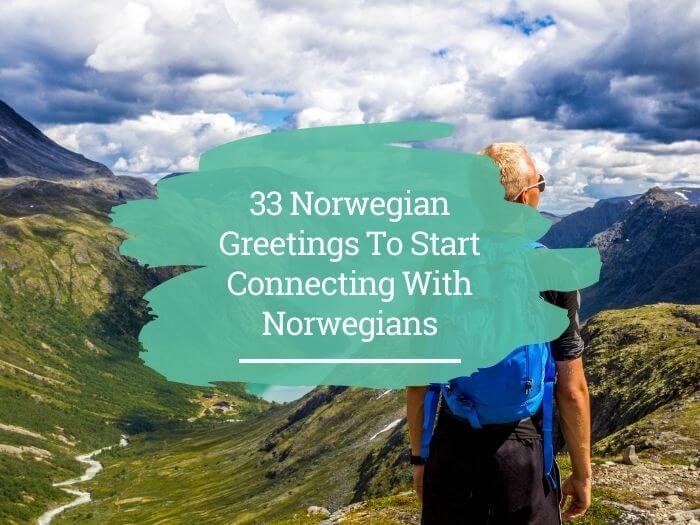As you're learning Norwegian, you probably know that the vikings weren't exactly known for formalities like Norwegian greetings – especially when it came to meeting other cultures.
Why bother to greet someone and introduce yourself when your principal aim is to hit them over the head or poke them with a knife anyhow?
Yet Norwegians have to say something once they meet each other. And as burning, raiding or stealing no longer qualifies as an introduction, they have come up with a variety of different versions to say “hello” and “goodbye”.
Let's discover 33 of these Norwegian greetings together so you can start chatting to Norwegians.
Pro Tip
By the way, if you want to learn Norwegian fast and have fun, my top recommendation is Norwegian Uncovered which teaches you through StoryLearning®.
With Norwegian Uncovered you’ll use my unique StoryLearning® method to learn Norwegian through story…not rules. It’s as fun as it is effective. If you’re ready to get started, click here for a 7-day FREE trial.
Table of Contents
Informal Norwegian Greetings – Without The Raids
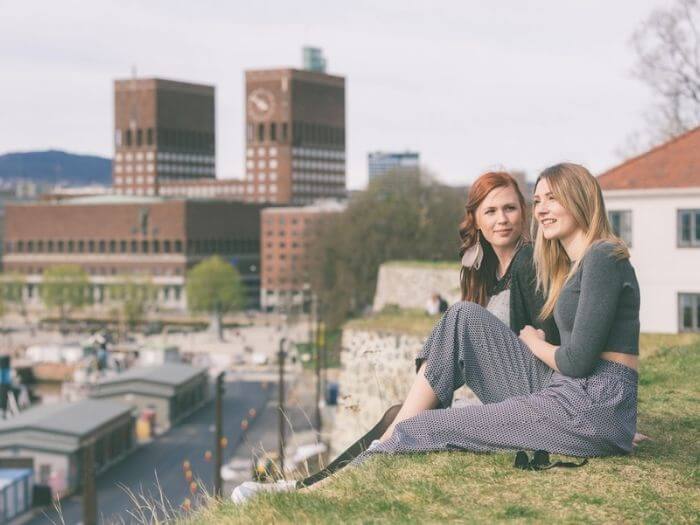
The most common way to say “hello” in Norwegian is:
1. Hei!
It's pronounced pretty much like “hi”.
The jury is still out on discussing whether Hei was taken over from the Old German/Dutch language – or if it's just a shortening of the now rather unpleasant sounding heil stemming way back to the Vikings.
Knowing the Norwegians’ respect for and pride of their own culture, my bet is on the latter.
Hei, though informal, is the greeting most used in everyday life. You can say it when seeing someone on the street, but also when you enter an office, a shop or to address anyone – no matter if you know the person beforehand, or not.
A more charming version of hei would be:
2. Heisann!
Heisann is used like Hei, an is pronounced as you read it. But it implies a certain amount of surprise – or even pleasure – when you accidentally meet someone you did not expect to see.
Using heisann as a greeting also suggests that you are familiar with the other person and even like him or her – though you can also pretend to do so by saying it!
If you want to play it cute – or be more intimate – you can say:
3. Hei Hei!
or
4. Hei På Deg!
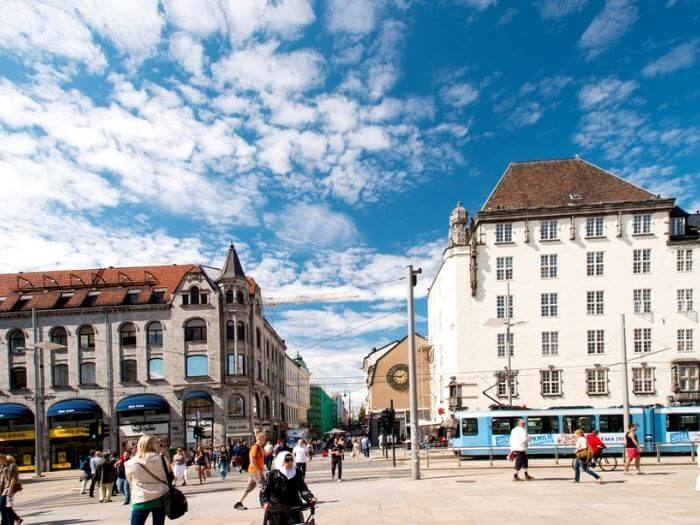
This greeting translates literally “hi to you”, but sounds really sweet in Norwegian as the pronunciation of deg rhymes with hei.
Both expressions indicate a greater sense of intimacy and are more common between close friends and relatives.
Another rather informal greeting you can use is a literal translation of the English “hello there”.
5. Hei Der! (Hello There)
Pronounced as you read it. Or:
6. Hei Du! (Literally “Hello You!”)
As in English, you can use both expressions as a greeting, but also as a call to stop someone in their tracks or to get their attention.
On very rare occasions, you also might be greeted by the Norwegian version of the German greeting hallo!
7. Hallo! (Hello On The Phone)

The ‘o’ at the end is pronounced like the ‘ou’ in “through”.
Hallo! is most often used in Norway at the beginning of a phone conversation and rarely when meeting someone in real life.
But it does happen, especially since some people might have problems switching off their mobile phone-mindset and forget that there also is a real world!
8. Halla! (Slang Version Of Hallo)
Halla! is not for the faint-hearted or unexperienced as it easily can sound like you’re inebriated or have a yet undiscovered speech impediment.
Norwegians are generally laid back and more comfortable with informal rites and rituals.
Nevertheless, let’s not forget that the country is also a European Monarchy – as well as a very wealthy nation with a lot of money found in especially oil production and the old shipping families.
And even though the former King Olaf V of Norway has been known for his close connection to his people, and his use of public transport to get to his favourite skiing haunts, it would pay to learn also some formal Norwegian greetings.
You never know who you might meet on the subway.
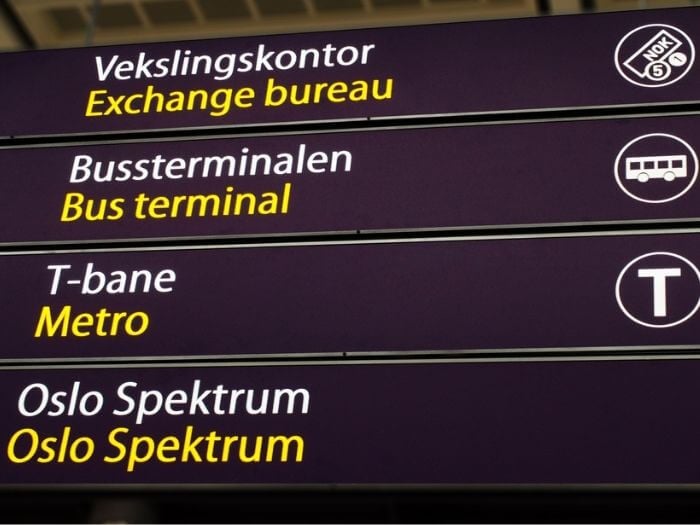
Formal Norwegian Greetings
Whether it’s “good”, guten (German) or goede (Dutch), formal greetings in languages deriving from Germanic roots will start with wishing someone something pleasant – never mind if it is actually a good day, or not so much.
As Norwegian belongs to the same language group, there’s no exception. The Norwegian way of formally greeting someone depending on the time of day is:
- God morgen (Good morning)
- God ettermiddag (Good afternoon)
- God aften/God kveld (Good evening, aften is a bit more formal though both words mean the same)
- God natt (Good night)
- God dag (Good day).
When it comes to Norwegian pronunciation, English language natives must be careful not to wish a Godly morning, day or afternoon.
The ‘d’ in the Norwegian god is silent, while the entire word is pronounced like ‘goo’ – simply like good without the ‘d’. The Norwegian word for God, by the way, is Gud (the ‘u’ pronounced like the ‘y’ in physics).
9. Good Ettermiddag
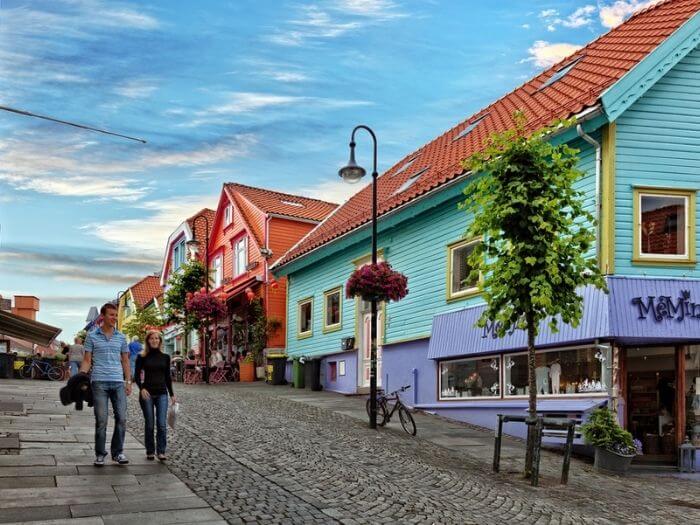
This greeting is not as widely used in Norway as it is in Britain, while God natt (Good night) is rather a goodbye at the end of a good night out – or a bedtime announcement.
10. God Morgen
You will mostly hear this in a work environment at the very beginning of the day. Once settled in ar the workplace and starting with the daily duties to be performed, most Norwegians will revert to the informal hei.
11. God Aften (Good Evening)
This greeting is especially necessary if you attend a formal – as in black tie – event. Greeting someone in a ball gown with hei in Norway will be frowned upon – unless it’s your best friend, your sister or your spouse.
Furthermore, in upscale restaurants you most likely will be greeted at the door with god aften – even though you might arrive in the middle of the night.
12. God Dag (Good Day)
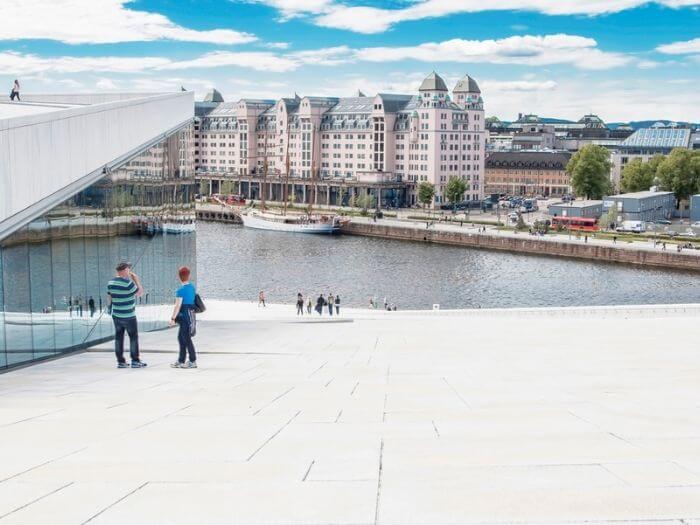
God dag is the most interesting of the formal Norwegian greetings. While it is used in business, ceremonial or official contexts, the expression can also be a tool for someone who wants to keep their distance.
If a person you thought you knew well suddenly greets you with a stern god dag instead of the more friendly hei, you better scroll down your memory to figure out what you might have done to offend them.
When it comes to determining when to say what at which point of the day, the rules are fluid.
Morning lasts till around lunch time, which in Norway starts at 11 o’clock due to most Norwegians arriving at work around 7 o’ clock in the morning.
The afternoon will start after lunch, while the evening is the time between dinner and the evening news.
Everything after is night.
Using daylight as a measure is useless in Norway. In the summertime, in most places the sun will go down around midnight and reappear at 1 am. In Winter, you might see the sun briefly at some point around mid-day. Blink, and you will miss it.
Not fluid, however, is the Norwegian meeting ritual, which does not differ much – if at all – between formal and informal.
The Norwegian Meeting Ritual
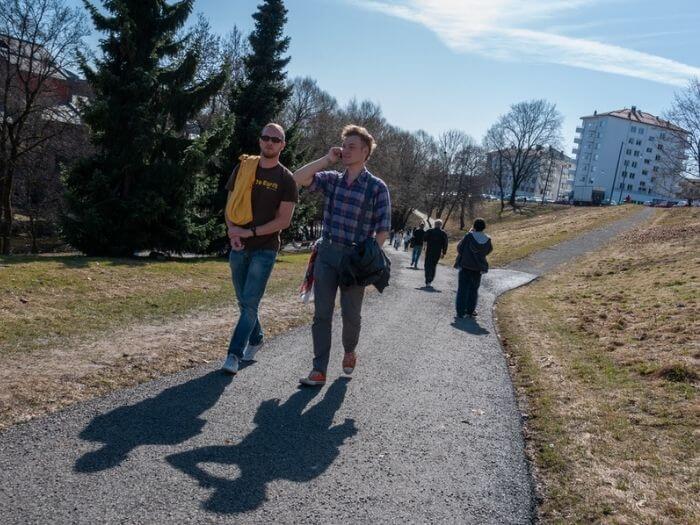
It doesn't matter who you are, where you meet and what your business is – the Norwegian way of conducting a conversation will always start out the same way. Two (or more) people encounter each other, and one of them will say:
14. Hei/Heisann/etc. Or God Morgen/Dag/Aften
Which one depends on if it’s a formal or informal meeting. The other(s) then will echo the original address. Then follows:
15. (Hvordan) Står Det Til? (How Are You?)
This translates as “how are you?”. Hvordan indicates a formal conversation, the abbreviated står til? is more common and informal.
The other most likely will answer:
16. Bra. Og Hvordan Står Det Til Med Deg? (Formal: Good. And How Are You?)
or
17. Bra. Og Du Da? (Informal: Good. And You?)
Once the other person has also acknowledged their general wellbeing, the conversation will move to the desired topic. This, Britons will be delighted to learn, more often than not will include the weather!
The answer bra (good) is almost a standard in the greeting ritual. However, if you know someone better or have an insight into their background, you sometimes might receive (or give) a more honest approach, like
18. Jeg Har Det Ikke Så Bra (Formal: I Don't Feel So Good)
or
19. Ikke Så Bra (Informal: Not So Good)

You'll still have to enquire about the wellbeing of the other person before you start elaborating on why you feel that way.
The same happens with the opposite where you think bra does not suffice to describe how happy you are:
20. Jeg Har Det Kjempebra! (I’m Doing Great!)
or even
21. Jeg Har Det Fantastisk! (I Feel Amazing!)
You should only use this one if you’ve found a new boy/girl friend or won the lottery.
A word of caution though: if you decide to deviate from the standard answer of bra (good), you need to wait for the encouragement from the other partner(s) in the conversation to clarify why you feel that way.
Getting into detailed explanations without being asked for it would be considered as rude. If it’s any consolation, not asking someone for an explanation when they're deviating from the standard is considered just as rude.
Meeting A Norwegian For The First Time

When you first start learning Norwegian, it's likely that you'll meet a lot of Norwegians for the first time.
If the occasion is in a professional or academic context, you're most likely required to use the formal version while introducing yourself:
22. God Dag. Mitt Navn Er… (Good day. My Name Is…)
or
23. God Dag. Jeg Heter… (Good Day. I Am Called…)
If the situation is already informal, as when you join a group with the same hobbies or interests or meet friends of friends the greeting and introduction below will suffice.
24. Hei, Jeg Heter… (Hello, I’m…)
The other will reply the same way.
When you enter a room and don't know where to find a person you want to introduce yourself to, you might want to say:
25. God Dag, Mitt Navn Er… Jeg Leter Etter… (Good Day, My Name Is… I am Looking For…)
Please note that using honorifics like Mr, Mrs or Ms is very unusual in Norway – though they exist.
- Herr (Mr)
- Fru (Mrs)
- Frøken (Miss)
Norwegians are generally comfortable with being on first name terms – even with strangers. If an occasion calls for a formal address, you use the first and last name – without the honorifics which last were in general circulation before World War II.
While Herr, Fru and Frøken might have left common usage, you'll only get an amused snicker if you should declare yourself – or someone else – as such.
There are, however, far more serious transgressions to look out for and avoid when meeting someone in Norway.
Norwegian No-Nos In Meeting And Greeting

While being friendly and incredibly helpful, I think nobody can accuse Norwegians of presenting themselves as an outwardly affectionate people. Norwegians like to keep their distance.
In most circumstances, a handshake will do in both formal and informal situations. Hugging is left to close family and friends and even there only upon invitation by whoever rules the roost.
Kissing belongs strictly to the ‘God forbid’ section. The Southern European way of doing both hugging and kissing among strangers is positively frowned upon, if not regarded with consternation, up North.
‘By invitation only’ is a central sentiment in Norwegian culture and society. However, once an invitation is pronounced, it needs to be taken seriously.
A friend of mine who uttered a barely audible “drop in when you’re over in the UK” during a brief meeting with a Norwegian couple found herself scrambling for bedding two years later when the pair appeared on her doorstep at midnight.
On the other hand, if a Norwegian pronounces an invitation and you accept – you are expected to fulfil your promise like an obligation. Norwegians do nothing half-heartedly and simply assume you feel the same
Norwegian Greetings: Saying Goodbye

As in the beginning of the conversation, there are several ways to conclude an encounter.
Before you say your final parting words, you might want to consider the following leads to prevent seeming abrupt:
26. Nå Må Jeg Skynde Meg (Now I Have To Rush)
or
27. Unnskyld Meg, Men Jeg Må Virkelig Gå Nå (Excuse Me, But I Really Have To Go Now)
or even
28. Se På Klokka! Jeg Er Nødt Til å Gå/Dra (Look At The Time! I’ll Have To Go/Leave)
Thereafter, you can say your goodbyes by using
29. Hadet (Bye, Literally “Have It”).
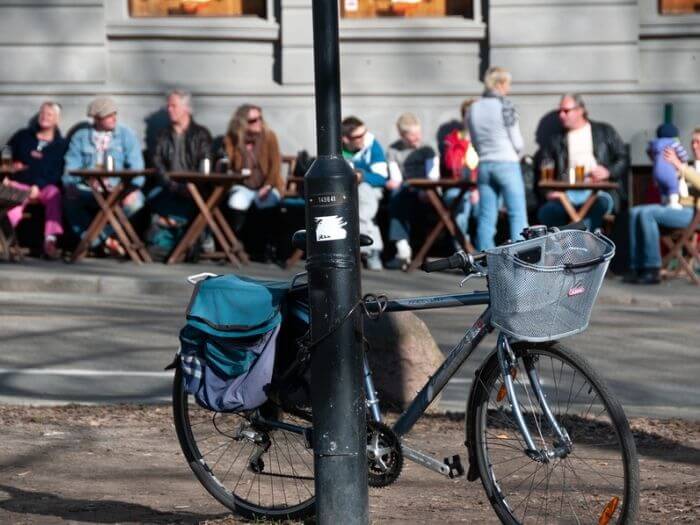
If this seems too short and succinct, you can elaborate to hadet bra (goodbye). Either is fine in an informal and to a certain extent formal situation.
If you expect to see the person again any time soon, you can add:
30. På Gjensyn (Formal: I Shall See You Again)
or
31.Vi Ses (Informal: See You Later)
Both also work as standalones, though most people would still add hadet either before or after. Two more formal ways to part would be:
32. Farvel (Farewell)
and
33. Adjø
This goodbye is from the French adieu and is pronounced the same way.
Farvel and Adjø, though still in use for formal occasions, belong to a rather old-fashioned section of the Norwegian language which is mostly spoken by the older generation of Norwegians.
Neither should be used together with hadet as you might seem to overdo it and want to get rid of the other person.
FAQs About Norwegian Greetings
What are some common Norwegian greetings?
1. Hei! (hello)
2. Heisann! (hello fo when you bump into someone by accident, or know them well).
3. Hei Hei! (a cute way to say hello)
4. Hei på deg! (translates literally ‘Hi to you’, but sounds really sweet in Norwegian as the pronunciation of deg rhymes with hei)
5. Hei der! (hello there)
6. Hei du! (translates literal as ‘Hello you!’)
7. Hallo! (the ‘o’ at the end is pronounced like the ‘ou’ in ‘through’).
8. Hallo! (hello on the phone)
9. Halla! (slang version of hallo)
10. God morgen (Good morning)
11. God ettermiddag (Good afternoon)
12. God aften/God kveld (Good evening, aften is a bit more formal though both words mean the same)
13. God natt (Good night)
14. God dag (Good day).
15. (Hvordan) står det til? (translates as ‘How are you?’ Hvordan indicates a formal conversation, the abbreviated står til? is more common and informal)
16. Bra. Og hvordan står det til med deg? (formal: Good. And how are you?)
17. Bra. Og du da? (informal: Good. And you?)
18. Jeg har det ikke så bra (formal: I don't feel so good)
19. Ikke så bra (informal: not so good)
20. Jeg har det kjempebra! (I’m doing great!)
21. Jeg har det fantastisk! (I feel amazing!).
22. God dag. Mitt navn er… (Good day. My name is…) or
23. God dag. Jeg heter… (literal: good day. I am called…).
24. Hei, jeg heter… (Hello, I’m…)
25. God dag, mitt navn er… Jeg leter etter… (God day, my name is… I am looking for…)
26. Nå må jeg skynde meg (Now I have to rush)
27. Unnskyld meg, men jeg må virkelig gå nå (Excuse me, but I really have to go now)
28. Se på klokka! Jeg er nødt til å gå/dra (Look at the time! I’ll have to go/leave)
29. Hadet (Bye, translates literally as ‘have it’)
30. På gjensyn (formal: I shall see you again)
31. Vi ses (informal: see you later)
32. Farvel (exactly what you thought it’ll mean: farewell)
33. Adjø (from the French Adieu and pronounced the same way).
What is a typical Norwegian greeting?
A typical Norwegian greeting is hei! which is “hello” in Norwegian.
Hei, though informal, is the greeting most used in everyday life. You can say it when seeing someone on the street, but also when you enter an office, a shop or to address anyone – no matter if you know the person beforehand, or not.
Another typical Norwegian greeting is God morgen which is “good morning” in Norwegian.
How do Norwegians greet each other?
Norwegians typically greet each other by saying hei (hello in Norwegian) or god morgen (good morning in Norwegian) depending on whether the situation is informal or formal.
They will then ask each other (Hvordan) står det til? (how are you?). In an informal setting, you can just say står til?. A typical reply would be bra (good).
While being friendly and incredibly helpful, Norwegians like to keep their distance. In most circumstances, a handshake will do in both formal and informal situations.
Hugging is left to close family and friends and even there only upon invitation by whoever rules the roost.
Kissing belongs strictly to the ‘God forbid’ section. The Southern European way of doing both hugging and kissing among strangers is positively frowned upon, if not regarded with consternation, up North.
How To Practise Norwegian Greetings

Now that you've discovered these 33 Norwegian greetings, you'll want to practise them.
Obviously, the best thing to do would be to find yourself a Norwegian to test our these Norwegian greetings on.
However, Norwegians might be hard to come by where you live. But the second-best solution would be to immerse yourself into Norwegian language content so you can see Norwegian greetings in context.
Here I can suggest using the Story Learning Method. To apply the method and read at your level, why not try out Norwegian short stories. You'll be able to see these Norwegian greetings in action and pick them up naturally as you read.
Vis ses! Hadet bra!

Olly Richards
Creator of the StoryLearning® Method
Olly Richards is a renowned polyglot and language learning expert with over 15 years of experience teaching millions through his innovative StoryLearning® method. He is the creator of StoryLearning, one of the world's largest language learning blogs with 500,000+ monthly readers.
Olly has authored 30+ language learning books and courses, including the bestselling "Short Stories" series published by Teach Yourself.
When not developing new teaching methods, Richards practices what he preaches—he speaks 8 languages fluently and continues learning new ones through his own methodology.
